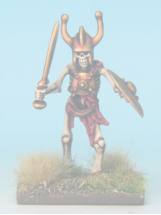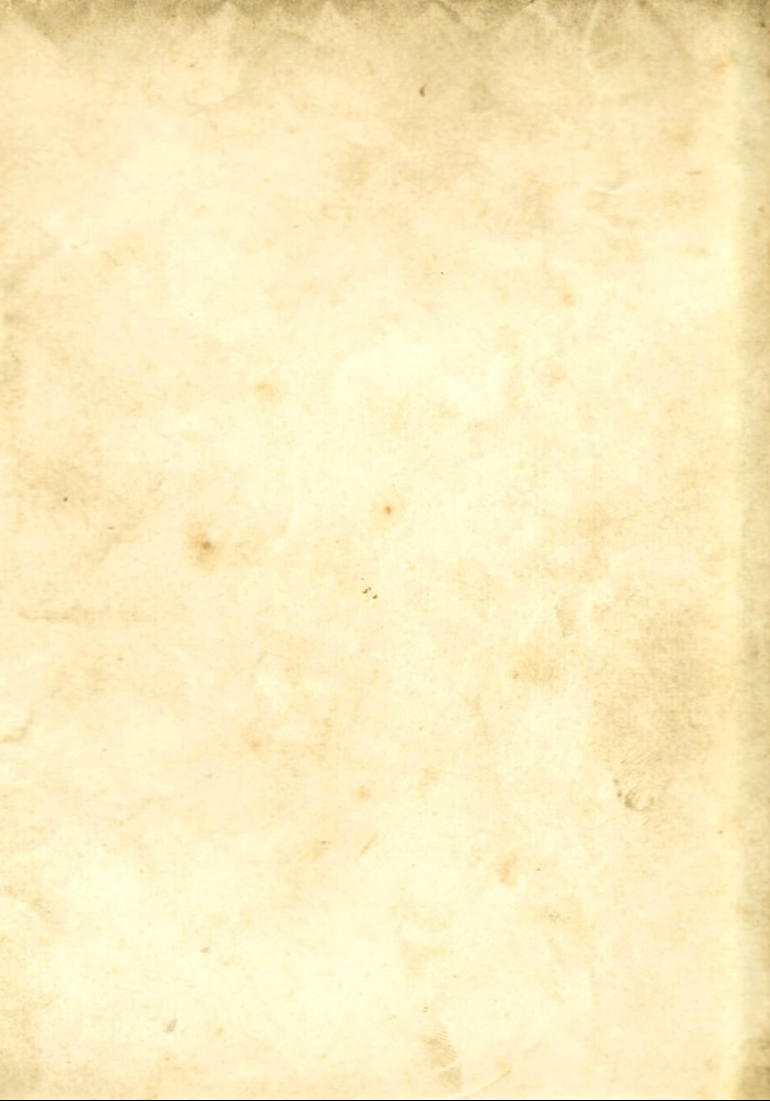
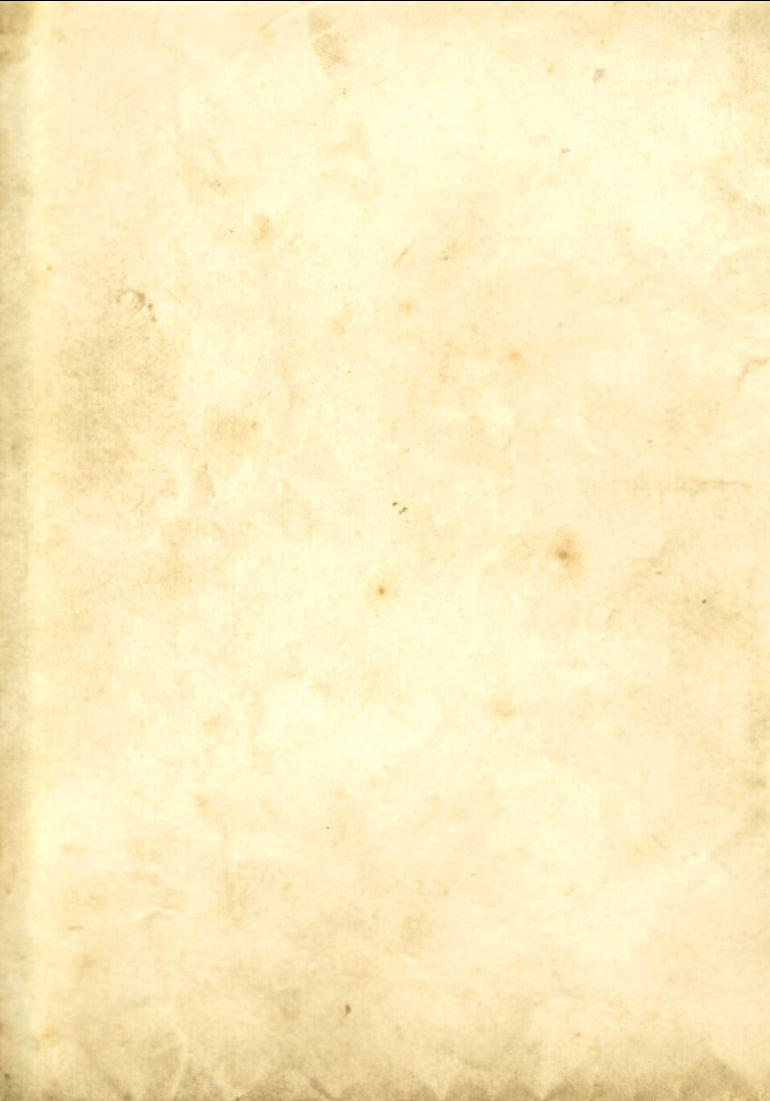
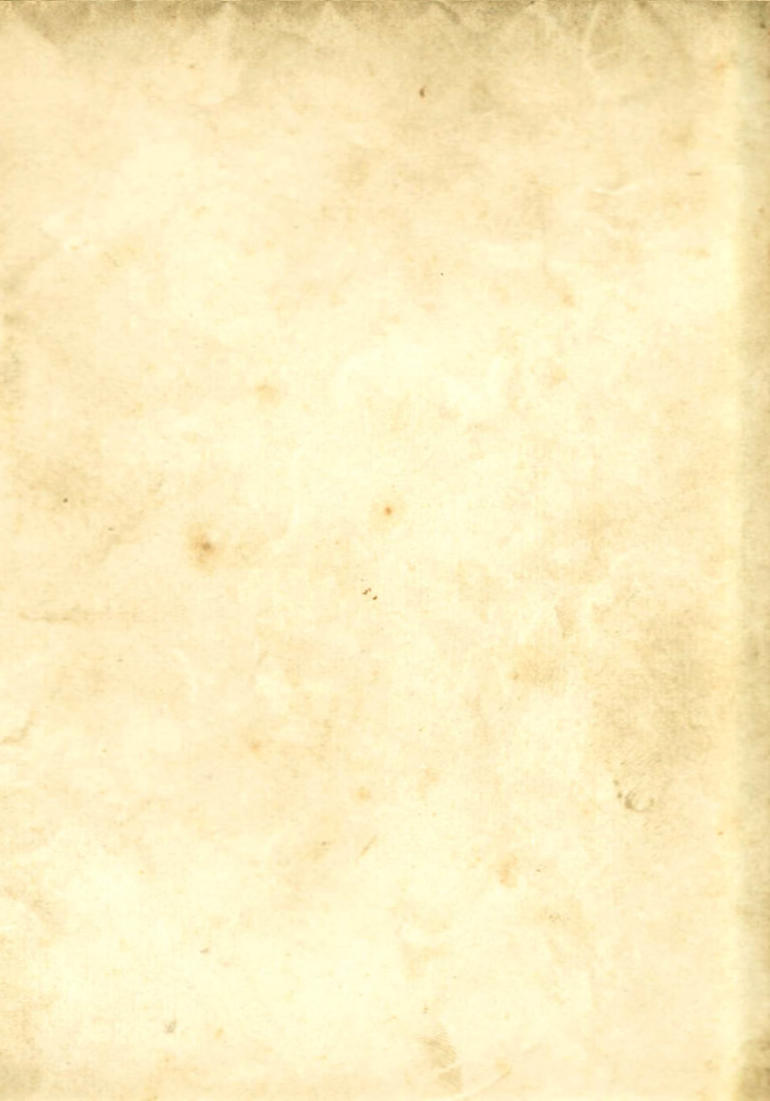
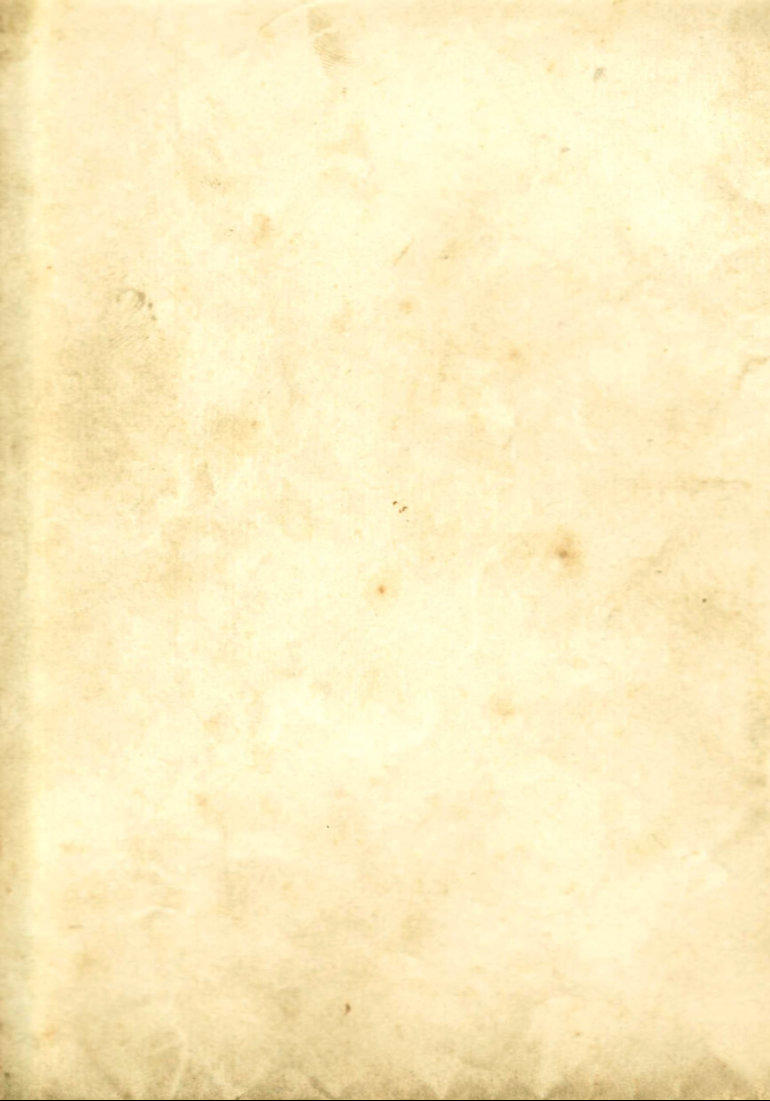

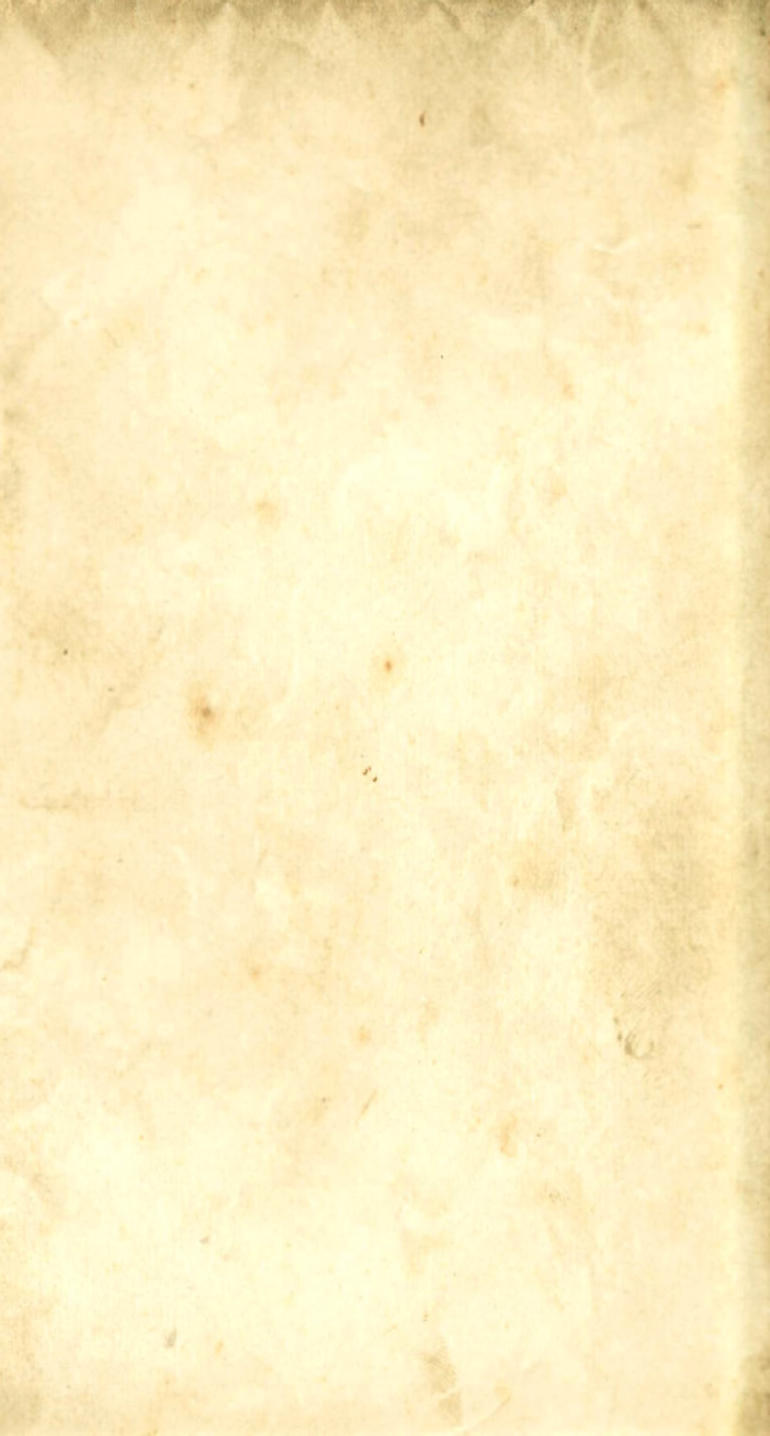
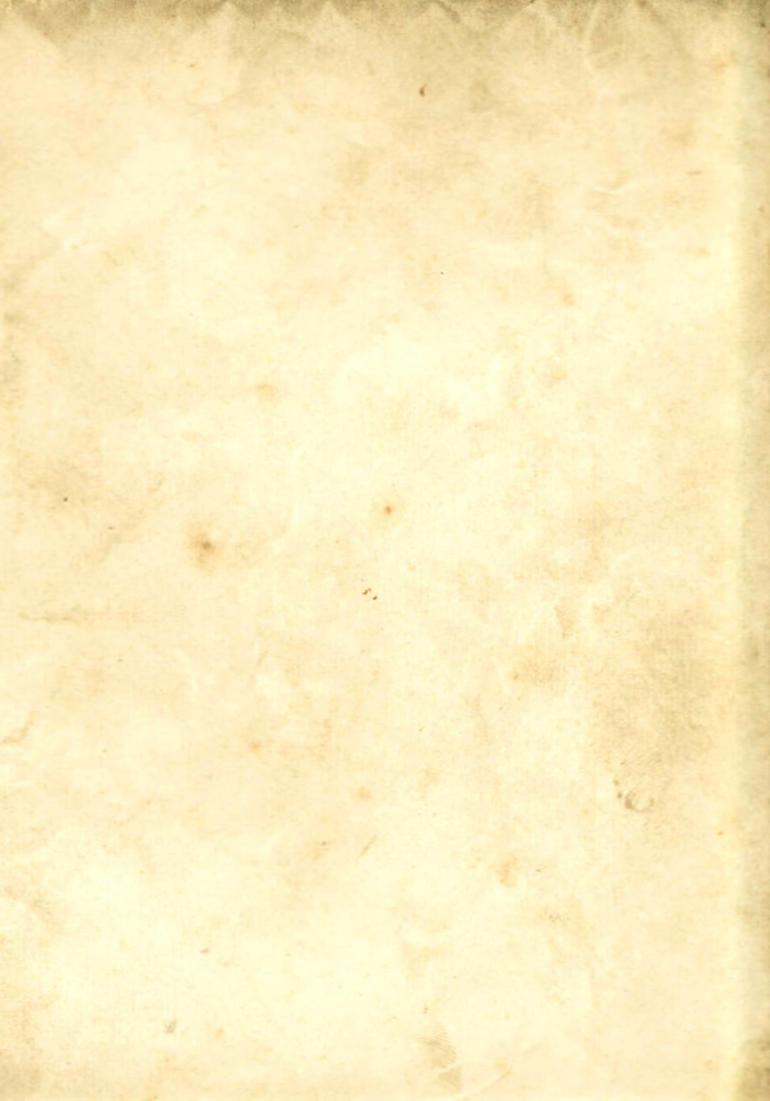
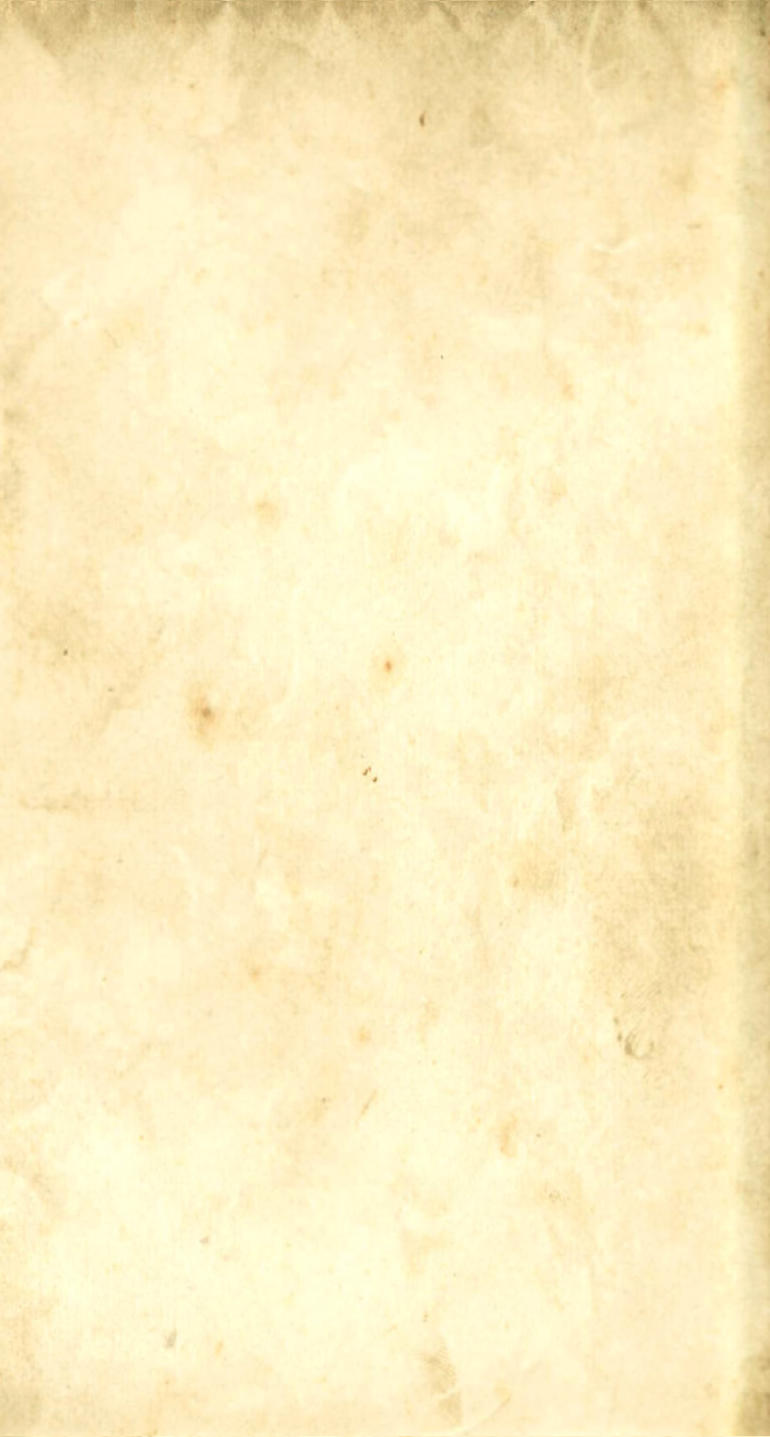
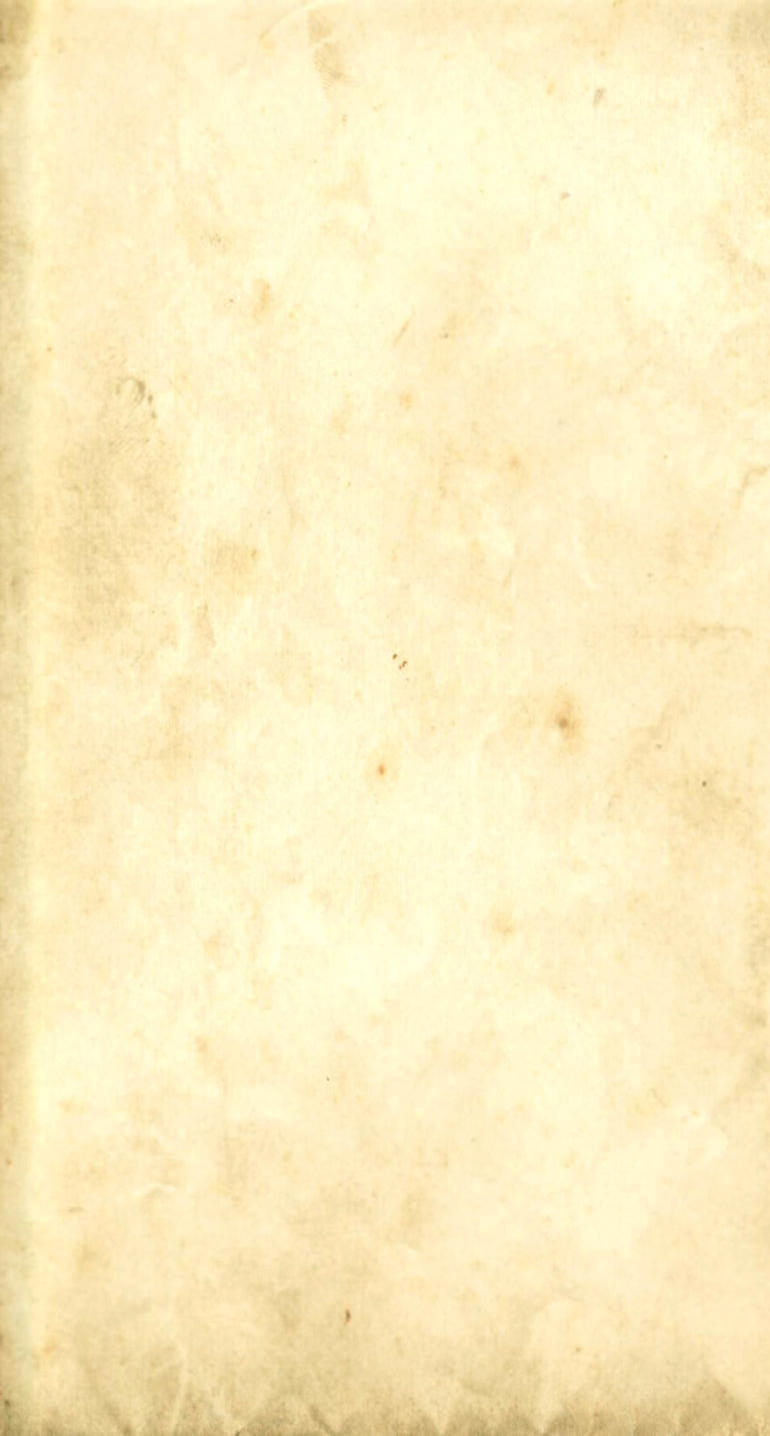




















The idea was “how to paint a skeleton from scratch”, that is literally from clipping off the frame to end. Also to show
is literally from clipping off the frame to end. Also to show four skeletons painted in four different ways, one in
four skeletons painted in four different ways, one in verdigris bronze armour, one in the bright bronze armour
verdigris bronze armour, one in the bright bronze armour similar to the Skeleton Soldiers units on the box cover,
similar to the Skeleton Soldiers units on the box cover, one in rusty old iron and one in dark damaged bronze
one in rusty old iron and one in dark damaged bronze armour. I varied the ways I painted the bones of some the
armour. I varied the ways I painted the bones of some the skeletons too, and as last twist I also varied the basing up
skeletons too, and as last twist I also varied the basing up as well!
as well! You might like to try one or some or all of the techniques,
You might like to try one or some or all of the techniques, whatever suits you or you could mix and match from each
whatever suits you or you could mix and match from each one to another to create other options.
one to another to create other options. Some of the stages are similar or the same on the
Some of the stages are similar or the same on the different models but I will mostly repeat them to save you
different models but I will mostly repeat them to save you having to scroll up and down to find relevant sections.
having to scroll up and down to find relevant sections. Assembling the
Oathmark Skeletons
In this article I will go through the approach I have to
Assembling the
Oathmark Skeletons
In this article I will go through the approach I have to putting together plastic kit Oathmark Skeletons,
putting together plastic kit Oathmark Skeletons, however the techniques would apply to any of the
however the techniques would apply to any of the numbers plastics now available.
numbers plastics now available. Things You Will Need
As follows: A very sharp knife or scalpel; liquid
Things You Will Need
As follows: A very sharp knife or scalpel; liquid polystyrene cement; small modelling side-cutters,
polystyrene cement; small modelling side-cutters, preferably a cutting matt or gash card to work on; old stiff
preferably a cutting matt or gash card to work on; old stiff paintbrush; sticking plasters.
Having a Butchers
When I am going to put together some of these multipart
paintbrush; sticking plasters.
Having a Butchers
When I am going to put together some of these multipart models plastic figures the first thing is to have a proper
models plastic figures the first thing is to have a proper look at the sprue and see what you have got to play with. I
look at the sprue and see what you have got to play with. I usually start with a body and then try various parts out to
usually start with a body and then try various parts out to see what I like, or copy an assembly someone else has
see what I like, or copy an assembly someone else has done that looks good. (Some people will wash the sprue
done that looks good. (Some people will wash the sprue before attempting assembles, but I have never done this).
Try Not to Snap
I carefully snip the parts off the sprue with small modelling
before attempting assembles, but I have never done this).
Try Not to Snap
I carefully snip the parts off the sprue with small modelling side-cutters, the sprue is fairly chunky so be careful, but
side-cutters, the sprue is fairly chunky so be careful, but the plastic itself isn’t brittle. Best not to try chopping at it
the plastic itself isn’t brittle. Best not to try chopping at it with a knife however, as is may snap in the wrong place,
with a knife however, as is may snap in the wrong place, and you may damage other important parts on the sprue
and you may damage other important parts on the sprue or even yourself! Once you have chopped all around the
or even yourself! Once you have chopped all around the part it should fall out, without needing to be snapped off. I
part it should fall out, without needing to be snapped off. I cut off just the bits I think I will for a whole model, body,
cut off just the bits I think I will for a whole model, body, arms, head and shield. Definitely do not try to snap parts
arms, head and shield. Definitely do not try to snap parts off with your bare hands or you will snap those bones.
off with your bare hands or you will snap those bones. Removing Lines
Some of the parts will need the fine mould lines removing
Removing Lines
Some of the parts will need the fine mould lines removing before assembly. I clean them up with a very very sharp
before assembly. I clean them up with a very very sharp (or brand new) scalpel, scraping along the mould lines to
(or brand new) scalpel, scraping along the mould lines to remove these and removing any marks left where I
remove these and removing any marks left where I chopped them off the sprue. I have a scalpel blade that I
chopped them off the sprue. I have a scalpel blade that I keep just to use for this purpose, I did try having a
keep just to use for this purpose, I did try having a whetstone handy to keep the blade sharp, but you can’t
whetstone handy to keep the blade sharp, but you can’t beat a blade that has only lightly touched plastic. BE
beat a blade that has only lightly touched plastic. BE VERY CAREFUL OF THE SHARP SCALPEL. Once you
VERY CAREFUL OF THE SHARP SCALPEL. Once you have successfully removed any mould lines, the fine
have successfully removed any mould lines, the fine 
 is literally from clipping off the frame to end. Also to show
is literally from clipping off the frame to end. Also to show four skeletons painted in four different ways, one in
four skeletons painted in four different ways, one in verdigris bronze armour, one in the bright bronze armour
verdigris bronze armour, one in the bright bronze armour similar to the Skeleton Soldiers units on the box cover,
similar to the Skeleton Soldiers units on the box cover, one in rusty old iron and one in dark damaged bronze
one in rusty old iron and one in dark damaged bronze armour. I varied the ways I painted the bones of some the
armour. I varied the ways I painted the bones of some the skeletons too, and as last twist I also varied the basing up
skeletons too, and as last twist I also varied the basing up as well!
as well! You might like to try one or some or all of the techniques,
You might like to try one or some or all of the techniques, whatever suits you or you could mix and match from each
whatever suits you or you could mix and match from each one to another to create other options.
one to another to create other options. Some of the stages are similar or the same on the
Some of the stages are similar or the same on the different models but I will mostly repeat them to save you
different models but I will mostly repeat them to save you having to scroll up and down to find relevant sections.
having to scroll up and down to find relevant sections. Assembling the
Oathmark Skeletons
In this article I will go through the approach I have to
Assembling the
Oathmark Skeletons
In this article I will go through the approach I have to putting together plastic kit Oathmark Skeletons,
putting together plastic kit Oathmark Skeletons, however the techniques would apply to any of the
however the techniques would apply to any of the numbers plastics now available.
numbers plastics now available. Things You Will Need
As follows: A very sharp knife or scalpel; liquid
Things You Will Need
As follows: A very sharp knife or scalpel; liquid polystyrene cement; small modelling side-cutters,
polystyrene cement; small modelling side-cutters, preferably a cutting matt or gash card to work on; old stiff
preferably a cutting matt or gash card to work on; old stiff paintbrush; sticking plasters.
Having a Butchers
When I am going to put together some of these multipart
paintbrush; sticking plasters.
Having a Butchers
When I am going to put together some of these multipart models plastic figures the first thing is to have a proper
models plastic figures the first thing is to have a proper look at the sprue and see what you have got to play with. I
look at the sprue and see what you have got to play with. I usually start with a body and then try various parts out to
usually start with a body and then try various parts out to see what I like, or copy an assembly someone else has
see what I like, or copy an assembly someone else has done that looks good. (Some people will wash the sprue
done that looks good. (Some people will wash the sprue before attempting assembles, but I have never done this).
Try Not to Snap
I carefully snip the parts off the sprue with small modelling
before attempting assembles, but I have never done this).
Try Not to Snap
I carefully snip the parts off the sprue with small modelling side-cutters, the sprue is fairly chunky so be careful, but
side-cutters, the sprue is fairly chunky so be careful, but the plastic itself isn’t brittle. Best not to try chopping at it
the plastic itself isn’t brittle. Best not to try chopping at it with a knife however, as is may snap in the wrong place,
with a knife however, as is may snap in the wrong place, and you may damage other important parts on the sprue
and you may damage other important parts on the sprue or even yourself! Once you have chopped all around the
or even yourself! Once you have chopped all around the part it should fall out, without needing to be snapped off. I
part it should fall out, without needing to be snapped off. I cut off just the bits I think I will for a whole model, body,
cut off just the bits I think I will for a whole model, body, arms, head and shield. Definitely do not try to snap parts
arms, head and shield. Definitely do not try to snap parts off with your bare hands or you will snap those bones.
off with your bare hands or you will snap those bones. Removing Lines
Some of the parts will need the fine mould lines removing
Removing Lines
Some of the parts will need the fine mould lines removing before assembly. I clean them up with a very very sharp
before assembly. I clean them up with a very very sharp (or brand new) scalpel, scraping along the mould lines to
(or brand new) scalpel, scraping along the mould lines to remove these and removing any marks left where I
remove these and removing any marks left where I chopped them off the sprue. I have a scalpel blade that I
chopped them off the sprue. I have a scalpel blade that I keep just to use for this purpose, I did try having a
keep just to use for this purpose, I did try having a whetstone handy to keep the blade sharp, but you can’t
whetstone handy to keep the blade sharp, but you can’t beat a blade that has only lightly touched plastic. BE
beat a blade that has only lightly touched plastic. BE VERY CAREFUL OF THE SHARP SCALPEL. Once you
VERY CAREFUL OF THE SHARP SCALPEL. Once you have successfully removed any mould lines, the fine
have successfully removed any mould lines, the fine 

How to Paint
Oathmark Skeletons
from Scratch
Above. The four painted Skeletons.
Above. Carefully snip the parts off the sprue with small
modelling side-cutters.
plastic detritus left should be carefully brushed into your bin with a stiff old paintbrush, otherwise this stuff gets
bin with a stiff old paintbrush, otherwise this stuff gets everywhere because of the static charge in it.
everywhere because of the static charge in it. Dry Runs
If you aren’t sure about how to assemble the parts, you
Dry Runs
If you aren’t sure about how to assemble the parts, you can hold the bodies up to the arms while still on the sprue
can hold the bodies up to the arms while still on the sprue and see if those will do, or have a dry run with some
and see if those will do, or have a dry run with some BluTack and see what works to your satisfaction. If you
BluTack and see what works to your satisfaction. If you are inexperienced with these kits, always try out an
are inexperienced with these kits, always try out an arrangement somehow before you commit it to gluing. You
arrangement somehow before you commit it to gluing. You can kind of tell what’s going to be successful once you
can kind of tell what’s going to be successful once you have done several hundred, but seriously, do study what
have done several hundred, but seriously, do study what good sculptors like Mark Copplestone do with their
good sculptors like Mark Copplestone do with their models and you will soon get the hang of it. After a while
models and you will soon get the hang of it. After a while you will be turning them out fast.
you will be turning them out fast. 
 bin with a stiff old paintbrush, otherwise this stuff gets
bin with a stiff old paintbrush, otherwise this stuff gets everywhere because of the static charge in it.
everywhere because of the static charge in it. Dry Runs
If you aren’t sure about how to assemble the parts, you
Dry Runs
If you aren’t sure about how to assemble the parts, you can hold the bodies up to the arms while still on the sprue
can hold the bodies up to the arms while still on the sprue and see if those will do, or have a dry run with some
and see if those will do, or have a dry run with some BluTack and see what works to your satisfaction. If you
BluTack and see what works to your satisfaction. If you are inexperienced with these kits, always try out an
are inexperienced with these kits, always try out an arrangement somehow before you commit it to gluing. You
arrangement somehow before you commit it to gluing. You can kind of tell what’s going to be successful once you
can kind of tell what’s going to be successful once you have done several hundred, but seriously, do study what
have done several hundred, but seriously, do study what good sculptors like Mark Copplestone do with their
good sculptors like Mark Copplestone do with their models and you will soon get the hang of it. After a while
models and you will soon get the hang of it. After a while you will be turning them out fast.
you will be turning them out fast. 
Assembling Skeletons
I usually glue the arms on first, and then I can see approximately which way the figure needs to be looking
approximately which way the figure needs to be looking and then glue the head on accordingly. Apply a tiny
and then glue the head on accordingly. Apply a tiny amount of cement to the arm the press it to the body and
amount of cement to the arm the press it to the body and hold for a short while to sort of tack it in place, you will still
hold for a short while to sort of tack it in place, you will still have a short while to reposition it if you are not happy.
have a short while to reposition it if you are not happy. Once you are happy with the position you can apply more
Once you are happy with the position you can apply more liquid cement to fix it in place. Then carry on attaching the
liquid cement to fix it in place. Then carry on attaching the other bits to complete your figure.
other bits to complete your figure.  This is not ABS
You can use any sort of good polystyrene cement; I use
This is not ABS
You can use any sort of good polystyrene cement; I use thick and thin types as the need arises. The thicker ones
thick and thin types as the need arises. The thicker ones can often be useful for tack things into place, they take
can often be useful for tack things into place, they take slightly longer to cure so can be useful if you do a lot of
slightly longer to cure so can be useful if you do a lot of repositioning, and then do the final gluing with the thin
repositioning, and then do the final gluing with the thin liquid cement. This is not ABS (Acrylonitrile Butadiene
liquid cement. This is not ABS (Acrylonitrile Butadiene Styrene) however; you won’t need anything terribly
Styrene) however; you won’t need anything terribly aggressive and the skeletons are by there nature quite
aggressive and the skeletons are by there nature quite fine and thin so don’t overdo the glue. Any of these
fine and thin so don’t overdo the glue. Any of these cements are quite serious stuff, so make sure you follow
cements are quite serious stuff, so make sure you follow the manufacturers instructions at all times.
Smoothing Out
To smooth out the places where I have cleaned off any
the manufacturers instructions at all times.
Smoothing Out
To smooth out the places where I have cleaned off any mould lines I go round with the liquid cement carefully
mould lines I go round with the liquid cement carefully 
 approximately which way the figure needs to be looking
approximately which way the figure needs to be looking and then glue the head on accordingly. Apply a tiny
and then glue the head on accordingly. Apply a tiny amount of cement to the arm the press it to the body and
amount of cement to the arm the press it to the body and hold for a short while to sort of tack it in place, you will still
hold for a short while to sort of tack it in place, you will still have a short while to reposition it if you are not happy.
have a short while to reposition it if you are not happy. Once you are happy with the position you can apply more
Once you are happy with the position you can apply more liquid cement to fix it in place. Then carry on attaching the
liquid cement to fix it in place. Then carry on attaching the other bits to complete your figure.
other bits to complete your figure.  This is not ABS
You can use any sort of good polystyrene cement; I use
This is not ABS
You can use any sort of good polystyrene cement; I use thick and thin types as the need arises. The thicker ones
thick and thin types as the need arises. The thicker ones can often be useful for tack things into place, they take
can often be useful for tack things into place, they take slightly longer to cure so can be useful if you do a lot of
slightly longer to cure so can be useful if you do a lot of repositioning, and then do the final gluing with the thin
repositioning, and then do the final gluing with the thin liquid cement. This is not ABS (Acrylonitrile Butadiene
liquid cement. This is not ABS (Acrylonitrile Butadiene Styrene) however; you won’t need anything terribly
Styrene) however; you won’t need anything terribly aggressive and the skeletons are by there nature quite
aggressive and the skeletons are by there nature quite fine and thin so don’t overdo the glue. Any of these
fine and thin so don’t overdo the glue. Any of these cements are quite serious stuff, so make sure you follow
cements are quite serious stuff, so make sure you follow the manufacturers instructions at all times.
Smoothing Out
To smooth out the places where I have cleaned off any
the manufacturers instructions at all times.
Smoothing Out
To smooth out the places where I have cleaned off any mould lines I go round with the liquid cement carefully
mould lines I go round with the liquid cement carefully 
Above. Fine plastic detritus left should be carefully brushed into your bin with a stiff old paintbrush.
into your bin with a stiff old paintbrush.
 into your bin with a stiff old paintbrush.
into your bin with a stiff old paintbrush.
“painting” over these marks just enough to soften them a bit. Do this possess very gingerly as you can easily
bit. Do this possess very gingerly as you can easily swamp the figure in glue if you are not very careful. This
swamp the figure in glue if you are not very careful. This painting also melts any fine plastic dust that may have
painting also melts any fine plastic dust that may have been left by the cleaning up process. The shininess of
been left by the cleaning up process. The shininess of some parts of the figures in the photos is an unfortunate
some parts of the figures in the photos is an unfortunate side effect of this glue painting. If you have any small
side effect of this glue painting. If you have any small gaps or discrepancies in the fit of any parts, try filling the
gaps or discrepancies in the fit of any parts, try filling the gap with a tiny off cut of sprue, then “painting” over it with
gap with a tiny off cut of sprue, then “painting” over it with your cement till it softens and melts into place. You can
your cement till it softens and melts into place. You can then trim this with your sharp knife to make a clean job of
then trim this with your sharp knife to make a clean job of it.
Some More Skeletons
This time I have concentrated on just one skeleton pose
it.
Some More Skeletons
This time I have concentrated on just one skeleton pose but painted in four different ways. To this end I made four
but painted in four different ways. To this end I made four almost identical skeletons to better illustrate the
almost identical skeletons to better illustrate the differences in the paintwork.
differences in the paintwork.  Leave your assembled models to harden at least
Leave your assembled models to harden at least overnight, the plastic takes time to regain strength after
overnight, the plastic takes time to regain strength after having been melted by the cements.
having been melted by the cements.  Painting the Skeletons
So I have assembled four, almost the same, skeletons.
Painting the Skeletons
So I have assembled four, almost the same, skeletons. Obviously I wouldn’t normally recommend making four
Obviously I wouldn’t normally recommend making four almost identical skeletons, but they were to serve a
almost identical skeletons, but they were to serve a particular purpose here.
particular purpose here.
 bit. Do this possess very gingerly as you can easily
bit. Do this possess very gingerly as you can easily swamp the figure in glue if you are not very careful. This
swamp the figure in glue if you are not very careful. This painting also melts any fine plastic dust that may have
painting also melts any fine plastic dust that may have been left by the cleaning up process. The shininess of
been left by the cleaning up process. The shininess of some parts of the figures in the photos is an unfortunate
some parts of the figures in the photos is an unfortunate side effect of this glue painting. If you have any small
side effect of this glue painting. If you have any small gaps or discrepancies in the fit of any parts, try filling the
gaps or discrepancies in the fit of any parts, try filling the gap with a tiny off cut of sprue, then “painting” over it with
gap with a tiny off cut of sprue, then “painting” over it with your cement till it softens and melts into place. You can
your cement till it softens and melts into place. You can then trim this with your sharp knife to make a clean job of
then trim this with your sharp knife to make a clean job of it.
Some More Skeletons
This time I have concentrated on just one skeleton pose
it.
Some More Skeletons
This time I have concentrated on just one skeleton pose but painted in four different ways. To this end I made four
but painted in four different ways. To this end I made four almost identical skeletons to better illustrate the
almost identical skeletons to better illustrate the differences in the paintwork.
differences in the paintwork.  Leave your assembled models to harden at least
Leave your assembled models to harden at least overnight, the plastic takes time to regain strength after
overnight, the plastic takes time to regain strength after having been melted by the cements.
having been melted by the cements.  Painting the Skeletons
So I have assembled four, almost the same, skeletons.
Painting the Skeletons
So I have assembled four, almost the same, skeletons. Obviously I wouldn’t normally recommend making four
Obviously I wouldn’t normally recommend making four almost identical skeletons, but they were to serve a
almost identical skeletons, but they were to serve a particular purpose here.
particular purpose here.
1. Skeleton
Verdigris Bronze Armour
Primed
He was undercoated with spray car primer, the next thing I did was to give him a spray coat of the Army Painter:
did was to give him a spray coat of the Army Painter: Leather Brown Colour Primer spray. These sprays are
Leather Brown Colour Primer spray. These sprays are very pigment heavy so be gentle with them, but make
very pigment heavy so be gentle with them, but make sure the grey is covered. You can get the Army Painter
sure the grey is covered. You can get the Army Painter sprays from our chums at Great Escape Games.
The next step was to spray him with the Army Painter:
sprays from our chums at Great Escape Games.
The next step was to spray him with the Army Painter: Skeleton Bone Colour Primer. I didn’t spray it on like an
Skeleton Bone Colour Primer. I didn’t spray it on like an undercoat in the normal random way, with the models now
undercoat in the normal random way, with the models now blue tacked to a piece of scrap card, this coat was
blue tacked to a piece of scrap card, this coat was sprayed from just one angle and this was from the top
sprayed from just one angle and this was from the top spraying towards the feet of the models while holding the
spraying towards the feet of the models while holding the spray can in the same plain as the models, not spraying
spray can in the same plain as the models, not spraying directly at them like you would normally when
directly at them like you would normally when 
 did was to give him a spray coat of the Army Painter:
did was to give him a spray coat of the Army Painter: Leather Brown Colour Primer spray. These sprays are
Leather Brown Colour Primer spray. These sprays are very pigment heavy so be gentle with them, but make
very pigment heavy so be gentle with them, but make sure the grey is covered. You can get the Army Painter
sure the grey is covered. You can get the Army Painter sprays from our chums at Great Escape Games.
The next step was to spray him with the Army Painter:
sprays from our chums at Great Escape Games.
The next step was to spray him with the Army Painter: Skeleton Bone Colour Primer. I didn’t spray it on like an
Skeleton Bone Colour Primer. I didn’t spray it on like an undercoat in the normal random way, with the models now
undercoat in the normal random way, with the models now blue tacked to a piece of scrap card, this coat was
blue tacked to a piece of scrap card, this coat was sprayed from just one angle and this was from the top
sprayed from just one angle and this was from the top spraying towards the feet of the models while holding the
spraying towards the feet of the models while holding the spray can in the same plain as the models, not spraying
spray can in the same plain as the models, not spraying directly at them like you would normally when
directly at them like you would normally when 
undercoating. Again be light in the spraying as these cans still put out a lot of paint! This mono directional technique
still put out a lot of paint! This mono directional technique is to try and create a shadow effect on the models. But it
is to try and create a shadow effect on the models. But it only works if you spray it from that one top down direction;
only works if you spray it from that one top down direction; it’s called Zenithal highlights in the trade.
it’s called Zenithal highlights in the trade.  But please go easy with the sprays as it can be quite easy
to clag the fine detail especially on a model like this.
Washed
Once the primer was properly dry, I applied a coat of Mid
But please go easy with the sprays as it can be quite easy
to clag the fine detail especially on a model like this.
Washed
Once the primer was properly dry, I applied a coat of Mid Brown Wash all over the bones. I did go back and blob
Brown Wash all over the bones. I did go back and blob some more on in places that I had either missed or I felt
some more on in places that I had either missed or I felt needed a bit more shade and I did remove some of the
needed a bit more shade and I did remove some of the bigger pools with my brush if too much had collected in
bigger pools with my brush if too much had collected in particular place, and again put him aside to dry.
particular place, and again put him aside to dry.
 still put out a lot of paint! This mono directional technique
still put out a lot of paint! This mono directional technique is to try and create a shadow effect on the models. But it
is to try and create a shadow effect on the models. But it only works if you spray it from that one top down direction;
only works if you spray it from that one top down direction; it’s called Zenithal highlights in the trade.
it’s called Zenithal highlights in the trade.  But please go easy with the sprays as it can be quite easy
to clag the fine detail especially on a model like this.
Washed
Once the primer was properly dry, I applied a coat of Mid
But please go easy with the sprays as it can be quite easy
to clag the fine detail especially on a model like this.
Washed
Once the primer was properly dry, I applied a coat of Mid Brown Wash all over the bones. I did go back and blob
Brown Wash all over the bones. I did go back and blob some more on in places that I had either missed or I felt
some more on in places that I had either missed or I felt needed a bit more shade and I did remove some of the
needed a bit more shade and I did remove some of the bigger pools with my brush if too much had collected in
bigger pools with my brush if too much had collected in particular place, and again put him aside to dry.
particular place, and again put him aside to dry.
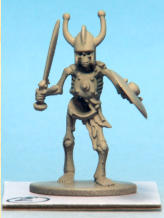
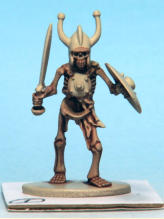
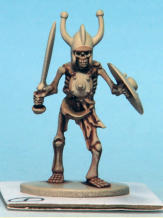
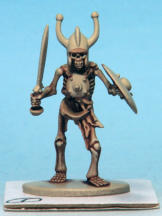
Bones
1.
Skeleton Bone, I tried not to paint out all of the washed over bones and also left the brown wash to show
washed over bones and also left the brown wash to show in all the depressions.
2.
Skeleton Bone plus Matt White, just on the high
in all the depressions.
2.
Skeleton Bone plus Matt White, just on the high points.
3.
and that’s it for the bones as I wanted to keep his
points.
3.
and that’s it for the bones as I wanted to keep his bones quite dark. It’s quite a quick method isn’t it! It
bones quite dark. It’s quite a quick method isn’t it! It would be good for massed units in Oathmark!
would be good for massed units in Oathmark!
 washed over bones and also left the brown wash to show
washed over bones and also left the brown wash to show in all the depressions.
2.
Skeleton Bone plus Matt White, just on the high
in all the depressions.
2.
Skeleton Bone plus Matt White, just on the high points.
3.
and that’s it for the bones as I wanted to keep his
points.
3.
and that’s it for the bones as I wanted to keep his bones quite dark. It’s quite a quick method isn’t it! It
bones quite dark. It’s quite a quick method isn’t it! It would be good for massed units in Oathmark!
would be good for massed units in Oathmark!
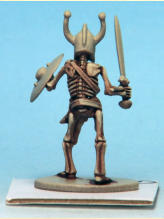
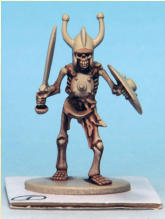
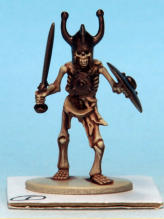
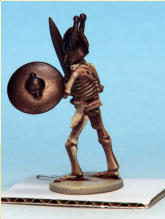
Bones. 2. Skeleton Bone plus
Matt White.
Bones. 3. that’s it for the
bones.
Metal. 1. Rough Iron.
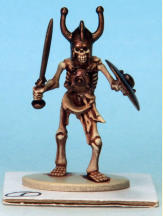
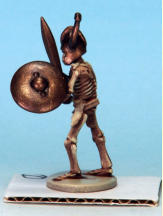
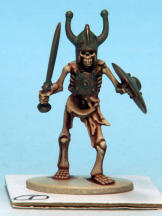
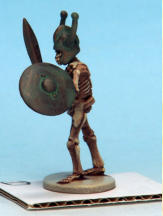
Metal. 2. Rough Iron plus True Copper.
Metal. 3. wash of Scaly Hide mixed with Green Tone Ink.
Straps
1.
Oak Brown plus Matt Black.
2.
pure Oak Brown.  3.
Oak Brown plus Desert Yellow.
4.
plus more Desert Yellow.
5.
plus more Desert Yellow just on the edges.
3.
Oak Brown plus Desert Yellow.
4.
plus more Desert Yellow.
5.
plus more Desert Yellow just on the edges.
 3.
Oak Brown plus Desert Yellow.
4.
plus more Desert Yellow.
5.
plus more Desert Yellow just on the edges.
3.
Oak Brown plus Desert Yellow.
4.
plus more Desert Yellow.
5.
plus more Desert Yellow just on the edges.
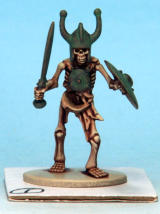
Metal. 4. another wash of Scaly Hide mixed with Green Tone
Ink.
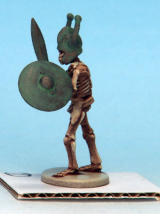
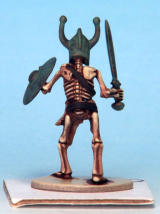
Straps. 1. Oak Brown plus
Matt Black.
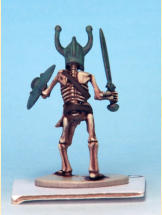
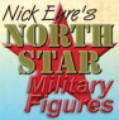

Clean them up with a very sharp scalpel, scraping along the mould lines to remove these.
Above. Have a dry run with some Blu-Tack and see what
works to your satisfaction.
Spray him with the Skeleton
Bone Primer.
Mid Brown Wash all over the
bones.
Bones. 1. Skeleton Bone.
Bones. 2. Skeleton Bone plus
Matt White.
Back of Shield
1.
Dirt Splatter.
2.
plus Desert Yellow.
3.
plus more Desert Yellow.
4.
plus Matt White.
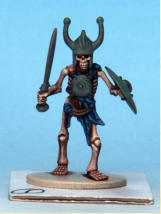
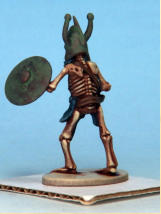
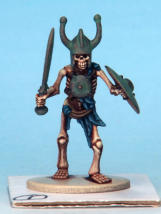
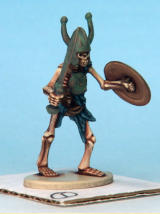
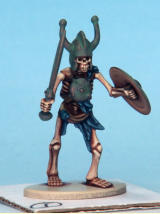
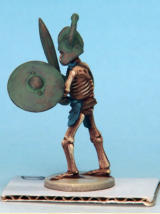
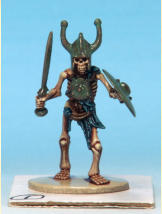
with Hombase DIY filler and then left that overnight to go hard.
hard.  1.
I then glued on some sharp sand with PVA glue and
1.
I then glued on some sharp sand with PVA glue and painted it Oak Brown.
2.
I then dry-brushed on Monster Brown.
painted it Oak Brown.
2.
I then dry-brushed on Monster Brown.  3.
I then dry-brushed on Desert Yellow.
3.
I then dry-brushed on Desert Yellow.  4.
finally I dry-brushed on lightly, Skeleton Bone.
4.
finally I dry-brushed on lightly, Skeleton Bone. I then added some of the Beige Tufts from Gamers
I then added some of the Beige Tufts from Gamers Grass.
Grass.  Then some Gale Force Nine: Meadow Blend Flock.
Then some Gale Force Nine: Meadow Blend Flock. The final touch is a very light dry-brush of Desert Yellow
The final touch is a very light dry-brush of Desert Yellow on the flock and he’s good to go.
on the flock and he’s good to go.
 hard.
hard.  1.
I then glued on some sharp sand with PVA glue and
1.
I then glued on some sharp sand with PVA glue and painted it Oak Brown.
2.
I then dry-brushed on Monster Brown.
painted it Oak Brown.
2.
I then dry-brushed on Monster Brown.  3.
I then dry-brushed on Desert Yellow.
3.
I then dry-brushed on Desert Yellow.  4.
finally I dry-brushed on lightly, Skeleton Bone.
4.
finally I dry-brushed on lightly, Skeleton Bone. I then added some of the Beige Tufts from Gamers
I then added some of the Beige Tufts from Gamers Grass.
Grass.  Then some Gale Force Nine: Meadow Blend Flock.
Then some Gale Force Nine: Meadow Blend Flock. The final touch is a very light dry-brush of Desert Yellow
The final touch is a very light dry-brush of Desert Yellow on the flock and he’s good to go.
on the flock and he’s good to go.
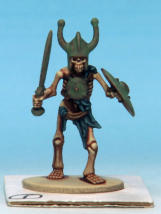
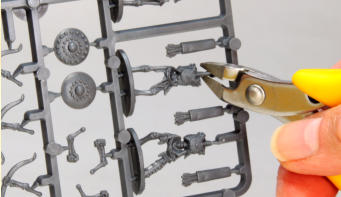
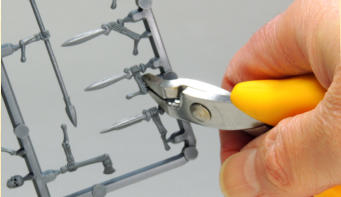
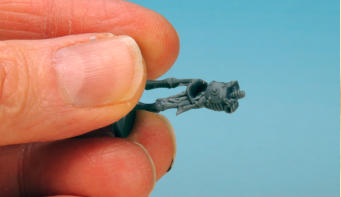
Above. Some of the parts will need the fine mould lines
removing before assembly.
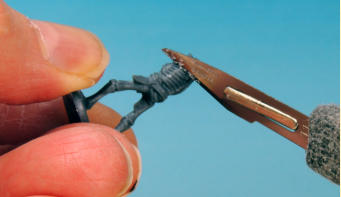
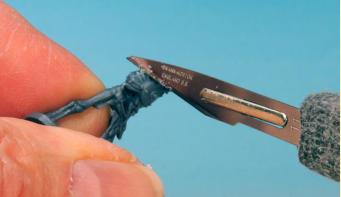
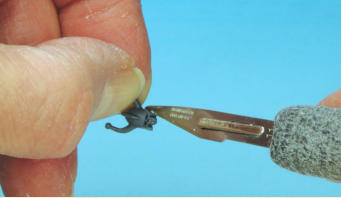
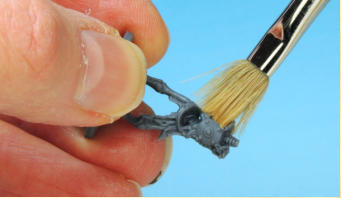


Above. Study what good sculptors like Mark Copplestone do
with their models and you will soon get the hang of it.
Above. Carefully “painting” over these marks just enough to soften them a bit. Do this possess very gingerly as you can easily swamp the figure in glue if you are not very careful.
swamp the figure in glue if you are not very careful.
 swamp the figure in glue if you are not very careful.
swamp the figure in glue if you are not very careful.
Above. Apply a tiny amount of cement to the arm the press it
to the body and hold for a short while to sort of tack it in
place, you will still have a short while to reposition it if you
are not happy.
Above. Four almost identical Skeletons to better illustrate the differences in the paintwork.
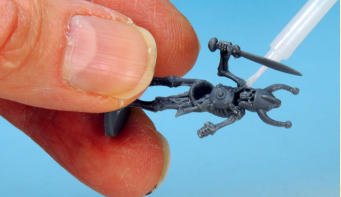
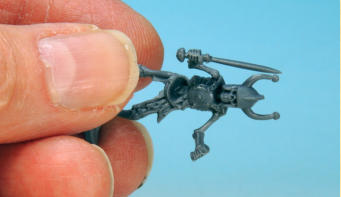
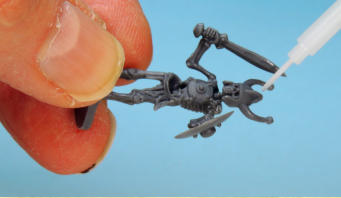

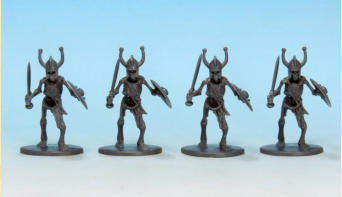
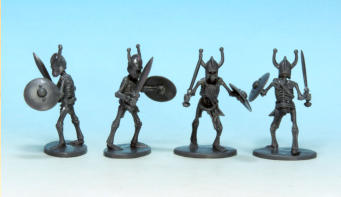
Above. Once you are happy with the position you can apply
more liquid cement to fix it in place. Then carry on attaching
the other bits to complete your figure.
Undercoating
Undercoating is essential as it provides a consistent surface on which to apply the next coats of paint. For
surface on which to apply the next coats of paint. For the undercoat I used Humbrol enamel matt black or
the undercoat I used Humbrol enamel matt black or grey car primer spray.
I brushed the Humbrol enamel on with a Warpaints
grey car primer spray.
I brushed the Humbrol enamel on with a Warpaints Small Drybrush brush making sure I covered the entire
Small Drybrush brush making sure I covered the entire model. Don’t let the paint pool anywhere as this will dry
model. Don’t let the paint pool anywhere as this will dry very thick and could obscure details. Also watch out for
very thick and could obscure details. Also watch out for any stray hairs detaching from your brush and sticking
any stray hairs detaching from your brush and sticking to the model during undercoating. Pull them off with
to the model during undercoating. Pull them off with tweezers before they become permanently attached!
tweezers before they become permanently attached! Take particular care not to clog up the face and similar
Take particular care not to clog up the face and similar fine detail areas, don’t be afraid to go back and clear
fine detail areas, don’t be afraid to go back and clear runs or blobs of undercoat off with your brush. I then let
runs or blobs of undercoat off with your brush. I then let 
 surface on which to apply the next coats of paint. For
surface on which to apply the next coats of paint. For the undercoat I used Humbrol enamel matt black or
the undercoat I used Humbrol enamel matt black or grey car primer spray.
I brushed the Humbrol enamel on with a Warpaints
grey car primer spray.
I brushed the Humbrol enamel on with a Warpaints Small Drybrush brush making sure I covered the entire
Small Drybrush brush making sure I covered the entire model. Don’t let the paint pool anywhere as this will dry
model. Don’t let the paint pool anywhere as this will dry very thick and could obscure details. Also watch out for
very thick and could obscure details. Also watch out for any stray hairs detaching from your brush and sticking
any stray hairs detaching from your brush and sticking to the model during undercoating. Pull them off with
to the model during undercoating. Pull them off with tweezers before they become permanently attached!
tweezers before they become permanently attached! Take particular care not to clog up the face and similar
Take particular care not to clog up the face and similar fine detail areas, don’t be afraid to go back and clear
fine detail areas, don’t be afraid to go back and clear runs or blobs of undercoat off with your brush. I then let
runs or blobs of undercoat off with your brush. I then let 
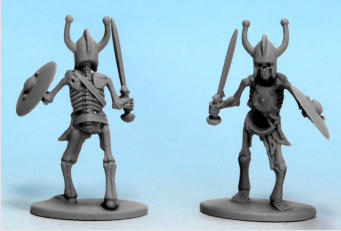
the undercoat dry completely before going on to paint the models. I spray the car primer very lightly in passing sprays, never linger to long with the spray.
I spray the car primer very lightly in passing sprays, never linger to long with the spray. 
 I spray the car primer very lightly in passing sprays, never linger to long with the spray.
I spray the car primer very lightly in passing sprays, never linger to long with the spray. 
Metal
1.
Rough Iron.  2.
Rough Iron mixed with True Copper.
3.
wash of Scaly Hide mixed with Green Tone Ink.
2.
Rough Iron mixed with True Copper.
3.
wash of Scaly Hide mixed with Green Tone Ink. You could leave it there but I wanted a more aged look.
You could leave it there but I wanted a more aged look.  4.
so another wash of the above!
4.
so another wash of the above! 
 2.
Rough Iron mixed with True Copper.
3.
wash of Scaly Hide mixed with Green Tone Ink.
2.
Rough Iron mixed with True Copper.
3.
wash of Scaly Hide mixed with Green Tone Ink. You could leave it there but I wanted a more aged look.
You could leave it there but I wanted a more aged look.  4.
so another wash of the above!
4.
so another wash of the above! 



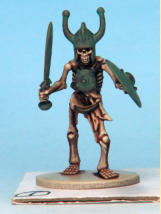
Straps. 5. plus more Desert Yellow just on the edges.
Straps. 3. Oak Brown plus
Desert Yellow.
Straps. 4. plus more Desert
Yellow.
Ragged Remnants
of Clothing
1.
Hydra Turquoise plus Matt Black. 2.
plus Hydra Turquoise.
2.
plus Hydra Turquoise. 3.
plus more Hydra Turquoise.
3.
plus more Hydra Turquoise. 4.
plus Matt White.
5.
plus more Matt White.
4.
plus Matt White.
5.
plus more Matt White.
 2.
plus Hydra Turquoise.
2.
plus Hydra Turquoise. 3.
plus more Hydra Turquoise.
3.
plus more Hydra Turquoise. 4.
plus Matt White.
5.
plus more Matt White.
4.
plus Matt White.
5.
plus more Matt White.
Straps. 2. pure Oak Brown.
Back of Shield.
Ragged Remnants of Clothing.
Finished Painting
That’s his painting completed.  Gloss Varnish
The model was then given a coat of Humbrol
Gloss Varnish
The model was then given a coat of Humbrol polyurethane gloss varnish and set aside for 24 hours
polyurethane gloss varnish and set aside for 24 hours to dry completely. Be careful not to let the varnish pool,
to dry completely. Be careful not to let the varnish pool, especially on the feet. You don't need a very thick coat of
especially on the feet. You don't need a very thick coat of varnish.
varnish. 
 Gloss Varnish
The model was then given a coat of Humbrol
Gloss Varnish
The model was then given a coat of Humbrol polyurethane gloss varnish and set aside for 24 hours
polyurethane gloss varnish and set aside for 24 hours to dry completely. Be careful not to let the varnish pool,
to dry completely. Be careful not to let the varnish pool, especially on the feet. You don't need a very thick coat of
especially on the feet. You don't need a very thick coat of varnish.
varnish. 
Painting completed.
Then a coat of gloss varnish.
Anti-Shine Matt Varnish.
Matt Varnish
Then they were given two coats of Anti-Shine Matt Varnish. Be even more careful when painting on the matt
Varnish. Be even more careful when painting on the matt varnish. When applying the matt, brush it out well from
varnish. When applying the matt, brush it out well from any nooks and crannies where it is likely to collect and
any nooks and crannies where it is likely to collect and pool.
Basing
The bases are 25mm square plastic ones that come with
pool.
Basing
The bases are 25mm square plastic ones that come with the skeletons. I used superglue to stick the model in
the skeletons. I used superglue to stick the model in place, blowing over them to prevent the glue whitening off
place, blowing over them to prevent the glue whitening off on the models.
I then filled in between the models bases and square base
on the models.
I then filled in between the models bases and square base 
 Varnish. Be even more careful when painting on the matt
Varnish. Be even more careful when painting on the matt varnish. When applying the matt, brush it out well from
varnish. When applying the matt, brush it out well from any nooks and crannies where it is likely to collect and
any nooks and crannies where it is likely to collect and pool.
Basing
The bases are 25mm square plastic ones that come with
pool.
Basing
The bases are 25mm square plastic ones that come with the skeletons. I used superglue to stick the model in
the skeletons. I used superglue to stick the model in place, blowing over them to prevent the glue whitening off
place, blowing over them to prevent the glue whitening off on the models.
I then filled in between the models bases and square base
on the models.
I then filled in between the models bases and square base 

Then Anti-Shine Matt Varnish.
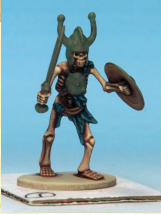
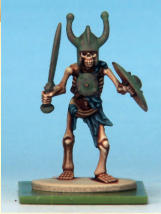
Superglue was used to stick
the model in place.
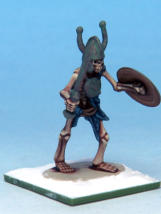
Basing. The base was then
filled with DIY filler.

Basing. 1. Sand is glued on
and painted Oak Brown.
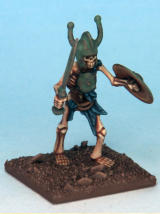

Basing. 3. Then dry-brushed
with Desert Yellow.
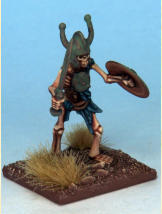
Basing. Gamers Grass Beige
Tufts were then added.
Basing. 2. Then dry-brushed
with Monster Brown.
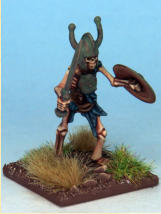
Basing. Gale Force Nine:
Meadow Blend Flock.
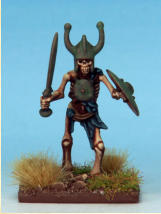
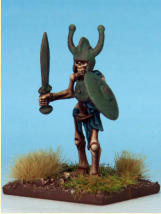
Finished Skeleton in Verdigris Bronze Armour.
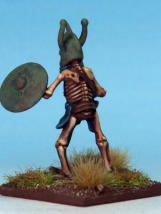
Basing. A very light dry-
brush of Desert Yellow.
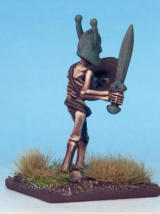
Finished Skeleton in Verdigris Bronze Armour


